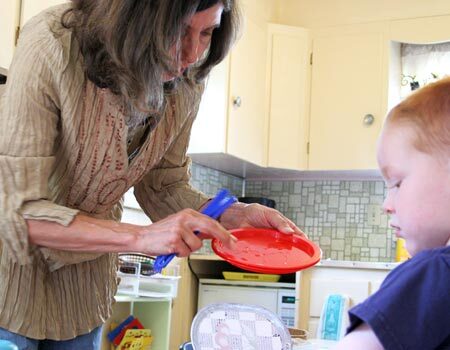What is Montessori?
At Northstar Montessori, we follow the Montessori Method for educating young children within the context of a developmentally appropriate preschool.
Our curriculum can be broken down into nine main categories:
Language
 Language is an all day, everywhere subject, so we use a variety of methods to teach basic skills. Children will learn to recognize the phonetic sounds of the alphabet through sight, sound, and touch. After that they will move onto reading and writing.
Language is an all day, everywhere subject, so we use a variety of methods to teach basic skills. Children will learn to recognize the phonetic sounds of the alphabet through sight, sound, and touch. After that they will move onto reading and writing.
Children also learn the alphabet by sight, through daily independent reading time as well as being read to by an adult or older child.
Math
 At Northstar Montessori, we have an entire room dedicated to the subject of math. We do simple counting exercises of everyday items and as the children master these, we expand into addition, subtraction, decimals, and currency.
At Northstar Montessori, we have an entire room dedicated to the subject of math. We do simple counting exercises of everyday items and as the children master these, we expand into addition, subtraction, decimals, and currency.
We may begin the school year by using sandpaper numerals, numerical rods, and spindle boxes, later expanding into the hundred board and the 45 layout. This opens many pathways for later learning of higher math skills.
Culture
 We want children to be aware of, and interested in, the world around them and how others live. Geography begins with an awareness of other places, built through talking about maps, singing songs, working on puzzle maps, and reading stories about far away places.
We want children to be aware of, and interested in, the world around them and how others live. Geography begins with an awareness of other places, built through talking about maps, singing songs, working on puzzle maps, and reading stories about far away places.
We incorporate celebrations from all over the world to further educate the children about other cultures. We use dramatic play to encourage socialization, awareness of occupations, as well as to build imagination.
Practical Life
 Practical Life activities take place everywhere all day long, starting when the children arrive and put their own things away in their personal cubbies, and continuing throughout their day. This encourages self-control, both mentally and physically.
Practical Life activities take place everywhere all day long, starting when the children arrive and put their own things away in their personal cubbies, and continuing throughout their day. This encourages self-control, both mentally and physically.
The children hang their things, put lunches away, learn to zip, snap, tie, scoop, spoon ladle and pour liquids.They also learn to care for a garden, for themselves, for the environment, and for each other.
Sensory & Motor Skill

Through manipulation of materials, children learn about color, sound, taste, smell, and touch. They also learn the relationship these items have with one another.
Materials such as geometric solids, knobbed cylinders, cylinders, trinomial cubes, binomial cubes, rough and smooth baskets, sensory tables, and rectangular prisms are just some of the items that help to enhance a child’s understanding of his/her physical environment. Sensorial activities are a great lead-in for math.
Science
 The children will be introduced to insects, plants, animals and many other items. They will be able to learn names and specifics about things in nature. We will talk about life cycles and growth patterns.
The children will be introduced to insects, plants, animals and many other items. They will be able to learn names and specifics about things in nature. We will talk about life cycles and growth patterns.
The children may plant a garden, nurture the plants, then harvest the vegetables to eat. This activity will increase awareness of where their foods come from.
Outdoor Play
 Staff and children go outside everyday, as weather permits. Our children are able to exercise their gross motor skills both outdoors and, in the event of inclement weather, in the lower level of the school interior. This is also a great place to socialize.
Staff and children go outside everyday, as weather permits. Our children are able to exercise their gross motor skills both outdoors and, in the event of inclement weather, in the lower level of the school interior. This is also a great place to socialize.
Music & Movement
 Our daily music and movement program teaches children the basics of rhythm recognition, keeping the beat, and simple dance. They also learn a wide variety of nursery rhymes and get a chance to be conductor of the day.
Our daily music and movement program teaches children the basics of rhythm recognition, keeping the beat, and simple dance. They also learn a wide variety of nursery rhymes and get a chance to be conductor of the day.
Art
 The creative process is very important in the development of young children, so most of our art projects are “open”. This means that the child will only be restricted by his/her imagination. Because of this approach, each child’s project will be highly individualized.
The creative process is very important in the development of young children, so most of our art projects are “open”. This means that the child will only be restricted by his/her imagination. Because of this approach, each child’s project will be highly individualized.
To honor your child and build their self-esteem, we encourage you to display your child’s artwork in your home, as we do at school.



